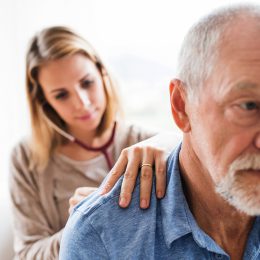5 Things Seniors Should Know About Ozempic
The news about this weight-loss wonder drug is everywhere these days. But is this diabetes medication the right fit for people over 65?

At the Harbor Health primary and specialty care clinic in Austin, Texas, Jodie L. Pepin, PharmD, counsels dozens of patients who’ve tried multiple medicines and diets to control their blood sugar, cholesterol, blood pressure or weight.
“They do all the right things and still only lose a few pounds, get frustrated and quit,” says Pepin, who directs Harbor Health’s clinical pharmacy program and is also a clinical assistant professor of pharmacy at the University of Texas at Austin. “For them, nothing works — until they go on a GLP-1 receptor agonist.”
The phrase “GLP-1 receptor agonist” is what medical professionals use to refer to a class of medications that in recent years have transformed the treatment of diabetes and obesity. They include semaglutide (Ozempic, Rybelsus, Wegovy), tirzepatide (Mounjaro, Zepbound), and dulaglutide (Trulicity), among others.
In addition to improving blood sugar control, medicines like Ozempic can lead to dramatic weight loss. They’ve become so popular that demand has outpaced their supply, leading to a worldwide shortage.
Despite their undeniable popularity, these new weight-loss drugs pose unique benefits and risks for people 65 and older. Here’s what seniors should know before trying them.
Add SilverSneakers to your wellness routine. Classes and events are happening right now at participating gyms, online through SilverSneakers LIVE, and at community centers near you. Activate your free online account to get started.
How Ozempic and GLP-1 Receptor Agonists Work
When you eat, your body releases a hormone known as glucagon-like peptide-1. It travels through your body and attaches to receptors on cells in your brain, gut and pancreas, says Karl Nadolsky, M.D. He is an endocrinologist and weight loss specialist at Holland Hospital in Michigan and co-host of the Docs Who Lift podcast.
When it attaches to receptors in the brain, GLP-1 helps keep you feeling full and turns down hunger cravings. In the gut, it empties food from the stomach more slowly, helping you feel full. In the pancreas, it triggers the secretion of insulin, a hormone that helps to shuttle blood glucose from your meal into cells.
In people with obesity, natural GLP-1 doesn’t work as effectively and is quickly broken down, says Dr. Nadolsky. Drugs like Ozempic mimic the hormone, turning up the volume on its effects, he says. The end result? You feel full sooner during a meal as well as less munchy between meals.
These injectable drugs are extremely effective at helping people lose weight. According to research, the average person loses about 15% to 20% of their total body weight. For someone who weighs 165, that’s about 25 to 33 pounds. They also can change the types of foods that you reach for.
“These medicines are a [game changer] because they almost immediately reduce someone’s cravings for carbs,” says Kimberly Gomer, M.S., R.D., a nutrition counselor in Miami who specializes in treating people 50 and older. “People get excited because they can eat just one cookie or one small slice of bread and feel satisfied,” she says.
The Upsides of Ozempic and GLP-1 Receptor Agonists Beyond Weight Loss
Because GLP-1 receptors exist throughout the body, these drugs may lead to other health benefits beyond blood sugar control and weight loss. In one review of studies involving more than 93,500 patients 65 and older who had diabetes, researchers determined that the medicines reduced major cardiac events like heart attacks and strokes. Other research hints at even more health benefits, including reduced blood pressure, cholesterol, inflammation, and blood vessel aging.
“These medicines are good for your heart and kidneys,” says Pepin. “And that’s if you lose no weight at all.”
Because of these positive effects, the American Diabetes Association has recommended using GLP-1 receptor agonists as one of the first treatment options for people with diabetes who are at high risk for heart disease.
What Seniors Need to Know About Ozempic
Despite their many pluses, these new medicines may also have downsides for older adults too. As people age, they tend to develop multiple health conditions requiring multiple medications, explains David Cutler, M.D. He’s a board-certified family medicine physician at Providence Saint John’s Health Center in Santa Monica, California. Because of that, older adults interested in trying a GLP-1 medicine should work closely with a health care professional and undergo frequent monitoring, he says.
When deciding whether to take a GLP-1 medicine, “You have to be aware of the potential risks and weigh that against the expected benefits,” says Dr. Nadolsky.
If you’re in your 60s or 70s and are experiencing several complications from obesity — joint pain, sleep apnea, and diabetes — a GLP-1 receptor agonist would likely help you solve many health problems with just one medicine, says Dr. Nadolsky. As your weight drops, your joint pain may lesson, sleep apnea could resolve, and diabetes might go into remission. In that case, the benefits far outweigh the risks, he says.
On the other hand, maybe you’re carrying around some extra weight. But your joints don’t hurt, your cholesterol and blood pressure are normal, you sleep great, and you don’t have diabetes. “Then suddenly the potential side effects and risks have to be weighed more cautiously,” says Dr. Nadolsky.
When deciding whether a weight loss medicine might be right for you, Dr. Nadolsky suggests asking your doctor these questions:
- Based on my age and health, what’s the probability that this medicine will improve my well-being, physical functioning, and quality of life?
- Based on my age and health, what’s the probability that this medicine will extend my life?
- Will this medicine help me to eventually go off other medicines?
You’ll also want to talk about the common side effects (see below), along with what you can do to lesson them.
The Side Effects of Ozempic and GP-1 Receptor Agonists
Beyond the considerations discussed above, these medications do come with some health complications. Here’s what you may expect if you start taking one of these drugs.
Increased GI woes. Slowed digestion can help you feel full longer, but it can sometimes come with unwelcome consequences like nausea, constipation, or diarrhea.
These side effects may be more noticeable and potentially dangerous after age 65, especially in people with diabetes who are more likely to already experience slowed digestion, a condition known as gastroparesis. These side effects can be more problematic with age, says Pepin.
“If you’re older and you get diarrhea, you don’t want to get dehydrated, which would worsen any kidney dysfunction,” she says. “Or dehydration could make you feel dizzy, leading to a fall and potential fracture.”
On the bright side, many of these side effects (especially the nausea) resolve over time, says Dr. Nadolsky. Others can be managed or prevented by altering the dosage of your medication as well as using the lifestyle advice below.
However, if you experience prolonged and severe diarrhea or nausea, you’ll want to mention it to your doctor.
Muscle loss. When you lose weight, not all of it comes from excess fat. Some of the weight drop comes from your muscle tissue.
“Due to the natural aging process, we already lose muscle mass,” says Pepin. “In the decade between 60 and 70, we lose 10%. If you’re going to lose 10% anyway, you don’t want to lose even more from rapid weight loss.”
Some muscle loss is a given — regardless of whether you lose weight with the help of a GLP-1 medicine or a restrictive diet. What’s important: You take steps to minimize it, says Dr. Nadolsky.
First, you’ll want to work closely with your doctor, he says. By starting with a low dose of medicine and then slowly increasing it, you’ll lose weight more slowly, helping to preserve muscle tissue. Second, follow your doctor’s advice for diet and exercise.
“Muscle loss isn’t not a reason to avoid treating obesity,” says Dr. Nadolsky. “It’s a reason to do more exercise. Exercise is important for everyone — and it’s even more important for people taking GLP-1 medicines.”
Weight regain. So, let’s say you don’t exercise. Then what? You’ll likely experience excessive muscle loss that can slow metabolism and worsen insulin resistance, says Dr. Cutler. This sets you up for weight regain, especially if you stop taking the injections.
“We’re concerned about people who demonstrate this yo-yo effect,” says Dr. Cutler. “Every time they lose weight, they will likely lose some muscle mass. And when they gain weight, they likely aren’t regaining that muscle mass. Then they go back on the drug, and they lose weight and lose more muscle mass and the cycle continues.”
The yo-yo effect is one reason it’s so important to undergo weight-loss treatment at a comprehensive medical practice. In addition to being monitored by a physician, you’ll ideally also meet regularly with a registered dietitian, physical therapist or exercise physiologist, and possibly even an orthopedist and sleep medicine professional, says Dr. Nadolsky.
Subscribe to our newsletter
It's quick and easy. You could be one of the 13 million people who are eligible.
Already a member? Click to discover our 15,000+ participating locations.
Follow Us
Surgical complications. Whether you’re scheduled for a colonoscopy or hip replacement, your healthcare professional will want your stomach to be empty. Because of the slowed digestion from drugs like Ozempic, it often takes more than 24 hours for the stomach to empty, says Dr. Cutler. That’s why the American Society of Anesthesiologists recommends people stop taking GLP-1 receptor agonists seven days before a procedure.
How to Sidestep the Risks
While these issues are concerning for seniors, you can overcome them by pairing your GLP-1 medication with healthy lifestyle changes, says Gomer. Here’s what experts recommend.
Exercise regularly. The older you are, the more important strength training becomes, says Dr. Nadolsky. Add rapid weight loss on top of your age and strength training becomes non-negotiable, he says.
Strength training serves as a powerful antidote to muscle loss, says Angela Fitch, M.D. She is the president of the Obesity Medicine Association and chief medical officer of knownwell, a health clinic in Needham, Mass.
One of her clients, in his mid 70s, lost 40 pounds of fat while on a GLP-1 receptor agonist. But he also gained 10 pounds of muscle because, after going on the medication, he started strength training, she says.
The Centers for Disease Control recommends 150 weekly minutes of moderate-intensity cardiovascular exercise and two or more weekly strength sessions for overall health. However, to maintain weight loss, you’ll need much more — roughly an hour of activity daily, says Dr. Fitch.
Recommended reading: The Best Strength-Training Workout for Beginners
Time your injections. The worst side effects tend to occur the day of and the day after the shot, says Pepin. If you administer the medication in the evening, you’ll sleep through the worst of the nausea, she says.
Keep fat intake in check. Fatty foods — even from healthy options like avocados and salmon — seem to worsen nausea and other digestive issues, says Gomer. So, avoid unhealthy fats from fried and highly processed foods. If fatty fish like salmon triggers nausea, switch to lighter options like mahi mahi, tilapia, and trout.
Increase fiber. To avoid constipation, focus on high-fiber foods like veggies, fruit and legumes. To boost your fiber intake, Pepin recommends grinding flaxseeds and mixing a tablespoon of them with water to drink every day. You can also blend them into oatmeal, yogurt or a smoothie.
Prioritize lean protein. Protein helps you to maintain your muscle mass. However, as you age, your protein needs increase, says Gomer. Try to include one to two protein-rich foods with every meal.
Recommended reading: 10 Ways to Sneak More Protein Into Your Diet
Think of a healthy lifestyle and your medication as two sides of a coin. You need both to see a payoff. “The medicine doesn’t replace lifestyle changes,” says Pepin. “If you make healthy lifestyle changes and take a GLP-1 receptor agonist, you’ll be much more likely to be successful.”
See our sources:
Ozempic and Wegovy shortages: American Society of Health-System Pharmacists
Glucagon-like peptide 1: Molecular Metabolism
Weight loss effects of semaglutide: Nature Medicine
GLP-1 RAs and cardiovascular and kidney health: The Lancet Diabetes & Endocrinology
GPL-1 RAs and stroke: Diabetes Research and Clinical Practice
GLP-1 RAs and type 2 diabetes: Journal of Clinical Pharmacy and Therapeutics
GLP-1 RAs and age-related disease: Aging and Disease
GLP-1 RAs and obesity: Obesity
GLP-1 RAs and kidney function: Diabetes, Obesity and Metabolism
Guidelines for new diabetes drugs: Centers for Disease Control and Prevention
GLP-1 RAs and anesthesiology: American Society of Anesthesiologists
Activate Your FREE SilverSneakers Online Account
Get hundreds of free SilverSneakers On-Demand videos and stay in touch with us by creating your free online account. You don’t have to be a SilverSneakers member to get on-demand workout videos, health and fitness tips from SilverSneakers, and more.
SilverSneakers members can go to thousands of nationwide gyms and fitness locations, plus take SilverSneakers LIVE online classes led by specially trained instructors and designed for all fitness levels and abilities – at no additional cost. If you have a Medicare Advantage plan, it may include SilverSneakers. Check your eligibility here.
Already a member? Get your SilverSneakers member ID, search for locations near you, and all the health and wellness resources you need by logging in to your online member account here.





